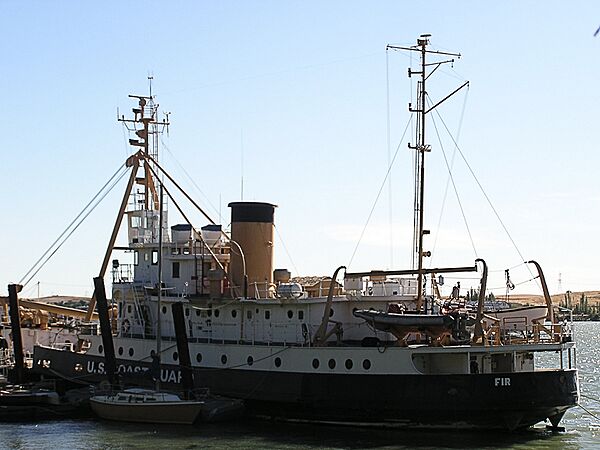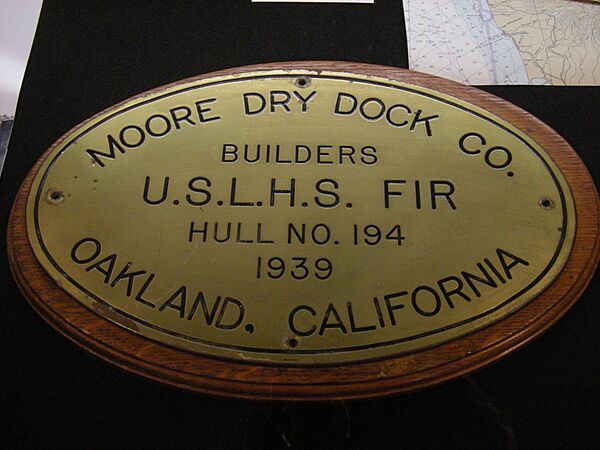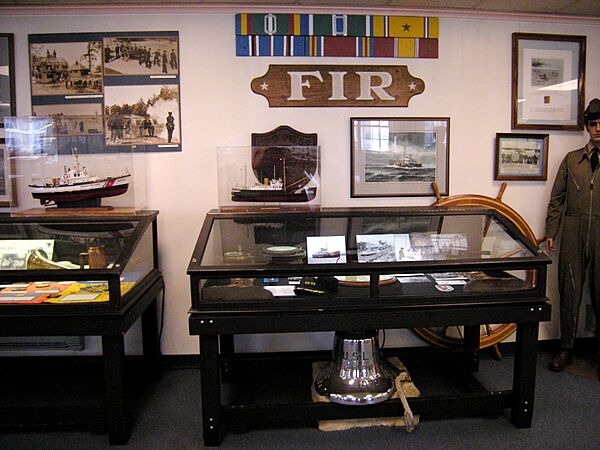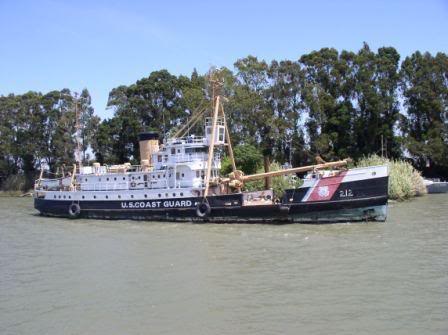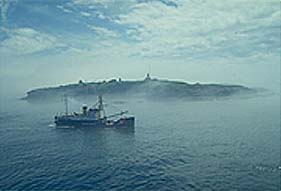USCGC Fir (WLM-212) facts for kids
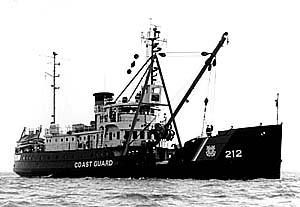 |
|
| History | |
|---|---|
| Namesake | Fir |
| Operator |
|
| Builder | Moore Dry Dock Company, Oakland, California |
| Cost | US$389,746 |
| Yard number | Hull number 194 |
| Laid down | 7 January 1939 |
| Launched | 18 May 1939 |
| Sponsored by | Miss Harriet Birta Mason |
| Christened | 18 May 1939 |
| Commissioned | 1 October 1940 (USCG) |
| Decommissioned | 1 October 1991 |
| Maiden voyage | 18 August 1939 to Portland, Oregon |
| Reclassified | WLM (1965) |
| Homeport | Seattle, Washington |
| Identification |
|
| Nickname(s) | Mother Fir, Building 212 |
| Honors and awards |
Queen of the Fleet 30 May 1988 |
| Status | |
| Notes | Call sign NRYR |
| General characteristics | |
| Class and type | Hollyhock class, type A |
| Type | Coast Guard, Auxiliary, General, Lighthouse tender WAGL; Coastal Buoy tender, WLM |
| Displacement | 885 tons. |
| Length | 174 ft 8+1⁄2 in (53.251 m) |
| Draft | 11 ft 3 in (3.43 m) |
| Ice class | Reinforced bow and stern. Ice-belt at water-line, notched forefoot. |
| Installed power |
|
| Propulsion |
|
| Speed | 12 knots (22 km/h; 14 mph) |
| Range | 2,000 mi (3,200 km) |
| Complement | 4 officers, 1 warrant officer, 69 enlisted (1945) |
| Crew | 74 (1945). |
| Sensors and processing systems |
Radar: SO-1 (1945); CS (1966). Sonar: WEA-2 (1945); UNQ-1 (1966) |
| Armament |
|
| Notes | Deck gear: boom, electrically powered, 20 ton hoisting capacity (1940); replaced in 1982 with hydraulic boom and A-frame system with a 15 ton hoisting capacity |
|
USCGC Fir
|
|
| Location | As of 2017: Stockton, California. |
| Built | 1939 |
| NRHP reference No. | 92001880 |
| Significant dates | |
| Added to NRHP | 27 April 1992 |
| Designated NHL | 27 April 1992 |
The United States Coast Guard Cutter Fir (WAGL/WLM 212) was a special ship. It was the very last lighthouse tender built for the United States Lighthouse Service. Its job was to bring supplies to lighthouses and lightships, and to take care of buoys in the water.
The Fir was built in Oakland, California, in 1939. It was a steam-powered ship with two propellers. It was about 175 feet long and could break through ice. The ship was built with beautiful wood like mahogany and teak. It cost about $390,000 to build. For most of its 51 years of service, the Fir was based in Seattle, Washington.
On July 1, 1939, the Lighthouse Service joined the United States Coast Guard. So, on October 1, 1940, the Fir became a U.S. Coast Guard Cutter. When World War II started, the Fir was painted grey and given weapons like machine guns and a 3-inch gun. It helped patrol the coasts and tow targets for gun practice. In 1965, its job title changed to a coastal buoy tender.
In 1988, the Fir became the oldest active ship in the U.S. Coast Guard. This meant it was named "Queen of the Fleet" and got special gold numbers on its bow. On October 1, 1991, after 51 years of service, the Fir was retired. A year later, it was named a National Historic Landmark.
Contents
What the Fir Did
The Fir was a very busy ship. It had many different jobs over the years.
Helping Lighthouses and Buoys
The main job of the Fir was to keep lighthouses and buoys working. It delivered coal, water, food, and mail to lighthouses and lightships. It also fixed and maintained buoys, which are like floating road signs for ships. The Fir even broke ice to keep shipping lanes clear.
Wartime and Rescue Missions
During World War II, the Fir helped protect the coast. It also took part in many search and rescue missions. For example, in 1949, it rescued 19 people from a ship called the MV Andalucia. In 1954, it helped the SS Beloit Victory when it was in trouble.
In 1958, the Fir came to the rescue of a Navy tugboat, Yuma, which was towing a large ship called Tinian. The Yuma had engine problems, and the Fir helped escort both ships to safety.
Recovering Wreckage
The Fir also helped recover sunken boats and aircraft. In 1958, it recovered two boats that sank during a hydroplane race. One of them was a Coast Guard patrol boat. In 1962, it salvaged a Coast Guard helicopter that had crashed.
Fighting Fires
The Fir even helped fight fires. In 1968, it assisted with firefighting at a shipyard in Seattle. In 1990, it put out a fire on a small boat and rescued the person trapped inside.
Last Big Project
For its very last project in 1991, the Fir went back to its original purpose. It helped renovate and restore the Cape Flattery Lighthouse on Tatoosh Island.
After Service
After the Fir was retired in 1991, many people hoped to turn it into a floating museum. However, this plan did not work out. In 1997, the ship was moved to Suisun Bay, California.
In 2002, the Fir was given to the Liberty Maritime Museum. It was moved to the Port of Sacramento and then to Rio Vista, California. The ship was later put up for sale. In 2017, a group called The Lighthouse Project LLC bought the Fir. They plan to restore it and use it to help with navigation projects again.
Awards and Honors
The Fir received several awards for its service:
- US Coast Guard Unit Commendation
- US Coast Guard Meritorious Unit Commendation
- American Defense Service Medal
- American Campaign Medal
- World War II Victory Medal
- National Defense Service Medal with two stars
Images for kids
- USCGC ''Fir'' (WLM-212)
-
Fir exhibit at Coast Guard Museum Northwest
![]() This article incorporates public domain material from websites or documents of the United States Coast Guard.
This article incorporates public domain material from websites or documents of the United States Coast Guard.
| Preceded by USCGC Ingham (WHEC-35) |
United States Coast Guard "Queen of the Fleet" 1988-1991 |
Succeeded by USCGC Storis (WMEC-38) |


